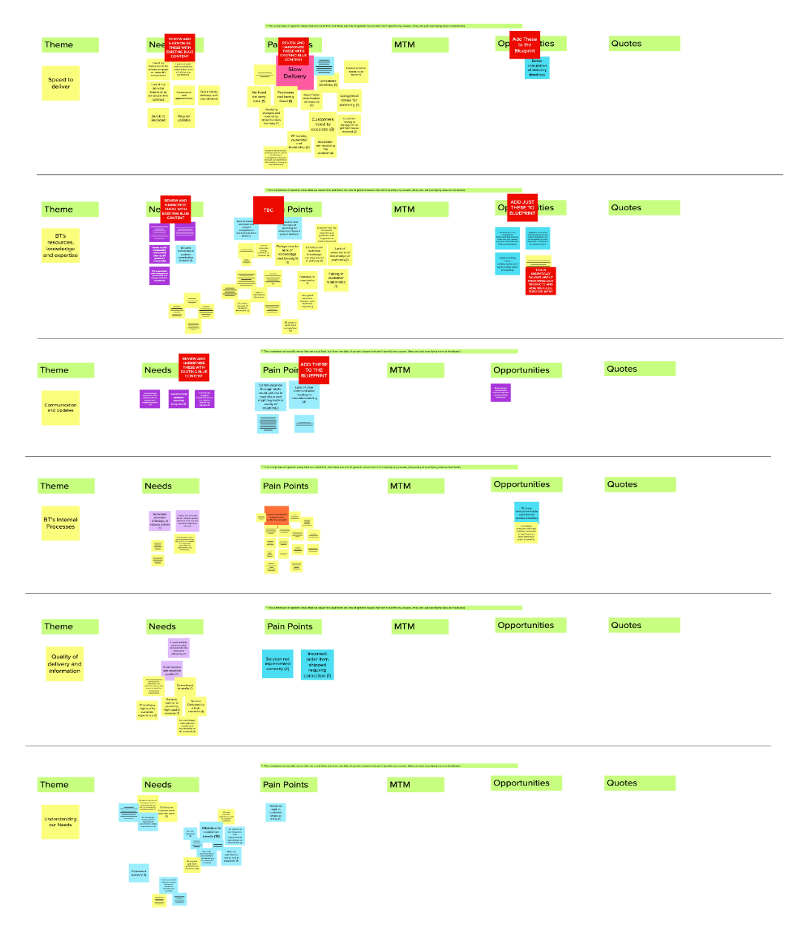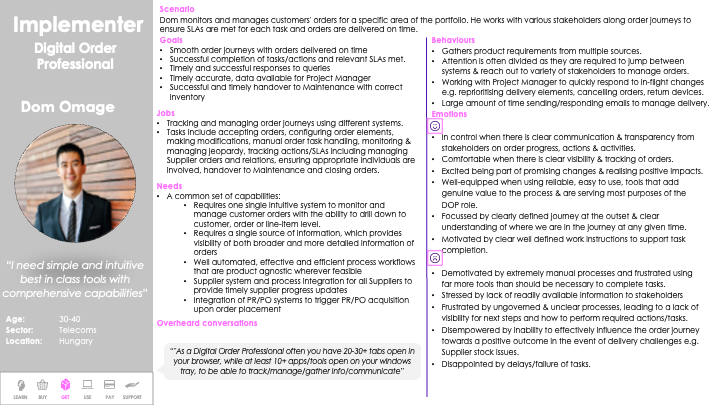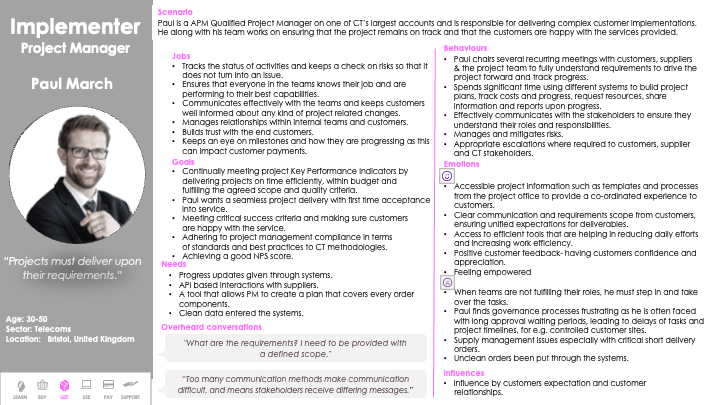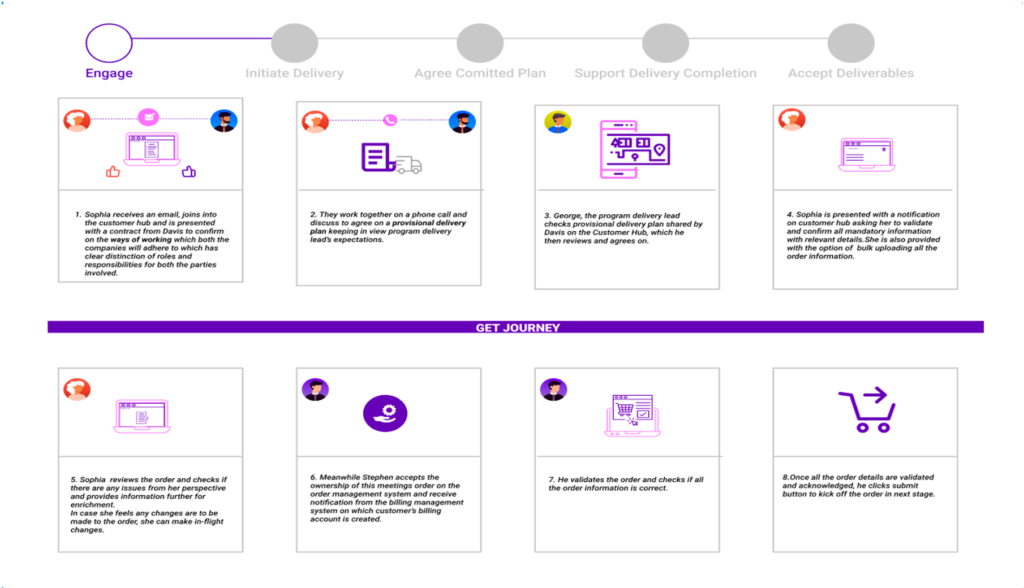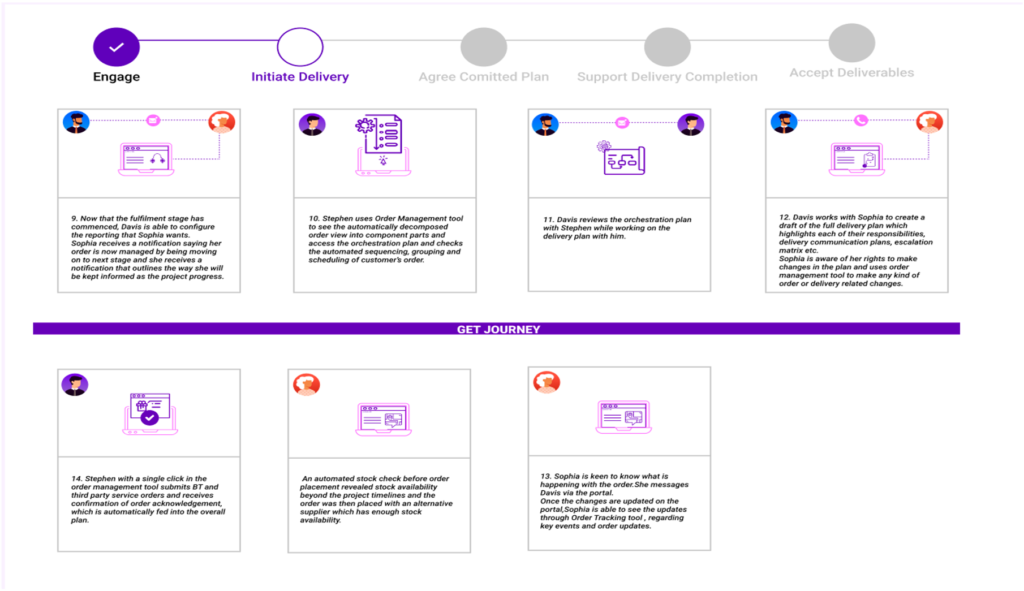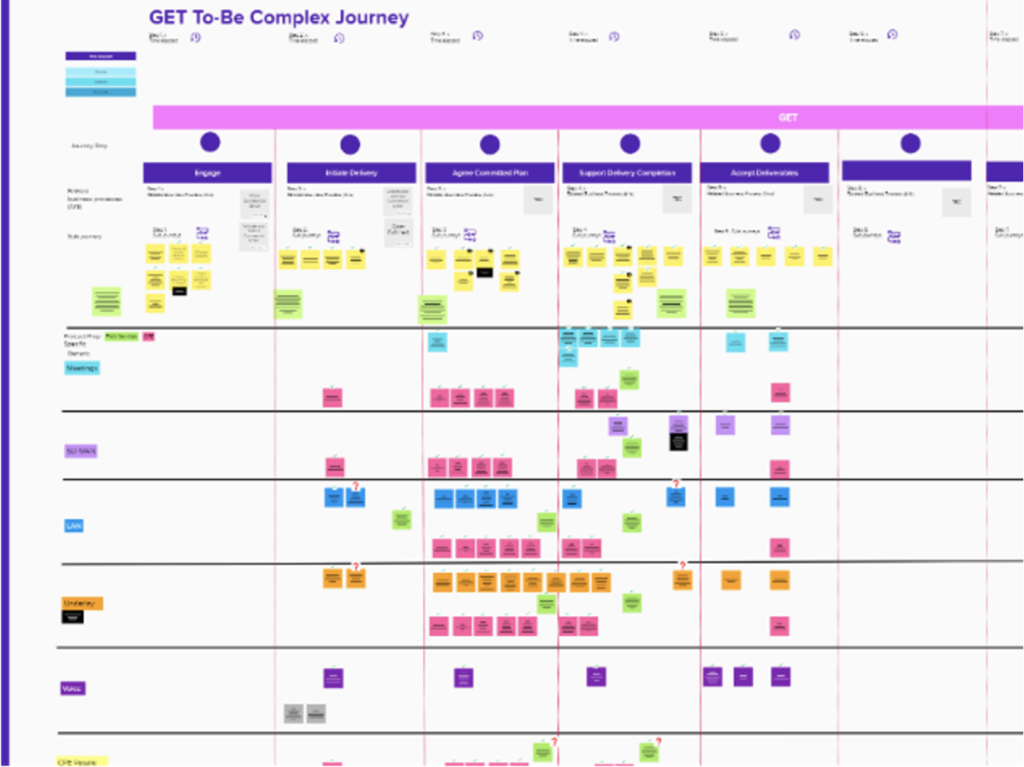Managing telecom services at scale is a complex process, involving multiple teams, systems, and technologies. In this case study, I worked on redesigning the fulfilment journey for Digico, a B2B telecom service provider offering networking and digital solutions. The goal was to streamline the process from order placement to service activation by identifying pain points, improving workflows, and enhancing customer experience. This study explores the challenges, research approach, and the impact of data-driven solutions in optimizing a highly intricate telecom fulfilment system.

Project Scope
- Client– British Telecom
- Timeframe– It was a long term project with parallel work going on in different stages of order life cycle journey. The project went over a period of 6 months.
- My role-UX Researcher
- Team– We were a team of three, I was the sole researcher working along with a Service Designer and UX designer.
- Method– In-depth qualitative colleague interviews, Personas, Experience Maps,Desk Research, Affinity Mapping, Survey Analysis, Empathy Mapping
- Tools– Mural,Adobe XD, Figma, Teams, Word Speech to text tool
Project Overview
![]() CLIENT KICKOFF
CLIENT KICKOFF
British Telecom is a telecommunications company that provides global security, cloud and networking services to multinational companies worldwide, with operations in 180 countries. BT’s management highlights their broadly digital and IT services as DigiCo. DigiCo is designing the future business and operating model of British Telecom by rethinking the experience of customers and colleagues, and re-imagining how to work end to end.The whole journey of a Digico order goes under several phases and one of them is Fulfilment, normally termed as GET within the organisation.
![]() OBJECTIVES
OBJECTIVES
- Envision the end to to end transformation of the FulFilment colleague and customer journey and designing a to-be Fulfilment journey.
- Understand the pain points and needs of customers and colleagues involved
- To produce a single Digico GET (Fulfilment) Service Design Blueprint along with supporting UX/CX artefacts that maps out a proposition agnostic journey (initially) of all actors involved and their various touchpoints.
- Dive into proposition specific journey at a later stage to map out the intricacies of different propositions involved.
![]() NOTES
NOTES
With the goal of rethinking entire Digico journey, simultaneous work was going on in different stages of Digico life cycle which in abbreviated form was termed as LBGUPS and for each stage a “To-be” journey was being designed.
The Process
Fulfilment (Get) is the phase of service delivery in which the customer receives the products or services offered by BT physically or virtually. All the steps starting right after the contract has been signed with the customer till actual delivery of the orders comes under Get. British Telecom’s goal was to rethink and enhance the experience of customers and its colleagues when in Get stage to ensure a smooth and hassle free delivery of the order.
The project aimed at creating a “To-be” Get journey depicted through a Service Blueprint artefact which gave me the opportunity to work closely with a service designer. I went ahead with a generative research stratergy to explore my research insights.The diagram below majorly focuses on my individual involvement and contributions that I could provide being the sole researcher.
 Stakeholder Mapping
Stakeholder Mapping
In the initial phase we started discussions with the team which included Process designers, , Service designers, Functionality analyst, Project managers to understand the actors involved in the Get journey. These were scheduled calls where the team would get together with us to help us understand the different phases of the get journey, what happens in these phases and who all actors get involved.
We realised that Digital order Professional and Programme manager play crucial role in the journey and they helped us map all the actors customer and colleague side with whom they interact while processing the order. This mapping helped us get a broader view of actors getting involved at different stages of the journey.
 In-depth Colleague Qualitative Interviews
In-depth Colleague Qualitative Interviews
In the initial phase we started discussions with the team which included process designers, project managers to understand the actors involved in the Get journey. These were scheduled calls where the team would get together with us to help us understand the different phases of the get journey, what happens in these phases and who all actors get involved.
Methodology
- With respect to taking interview, I was the interviewer, and the service designer was the note taker. We scheduled 1 hour interview sessions which focused on understanding the participants nature of work, their work responsibilities and their role in Get stage, interactions, their needs and the problems they are facing.
- Screener- We realized that there were few actors involved at the beginning stages of the get journey who had primary roles to play so we started with their interviews first. Digital Order Professional, Project Manager, Program Delivery Lead were few of the roles we started our interview with.
- Remote Moderation- These were 1-hour interviews conducted online via teams and recorded with participant’s permission.
Interview Findings
- The detailed interview sessions helped us in mapping the individual involvement of these actors in different phases of the get journey.
- Got to understand the frustrations and pain points these actors are facing and recognize the gap for improvement.
- Discussions with project manager helped us in understanding the basics of different propositions.
 Customer Research
Customer Research
In order to get customer insights we had to dig down deep and find ways to get some insights so as to understand customers point of view and involvement across the Get journey.
The Process
- Since there was no customer research done specifically on get journey we started with proposing conducting customer research through a detailed research plan.
- We conducted surveys across 390 customers to identify answers to some overarching questions with regards to order delivery such as – How are customers finding current engagement experience, are they happy with the overall delivery process and what could better work for them.
- The surveys were sent to existing large and large spending customers with whom the client has been doing business with. This survey was majorly directed to Project manager and Project Delivery Manager role.
Data Analysis
- The survey data was analysed through affinity mapping where we could cluster insights into bigger themes which later became the sub themes of research findings.
- We counted the negative insights under each theme to determine the biggest problem faced by the client.
Research Findings
We identified customer problems and needs across different categories, and we realized that the biggest single-issue customers were facing in the get journey is slow delivery of their orders. We also analysed that complex company processes, resource competence and unavailability and lack of clear communication are some of the areas where customers are not overtly satisfied with client.
- Slow order delivery timelines for projects causing unhappy customers.
- Complex processes creating impact on customer satisfaction
- People Issues – (i)Availability, (ii)Competence, (iii)BT not working as a partner, (iv)Organizational Complexity
- Lack of clear communication and delays in response leading to misunderstanding for the customers.
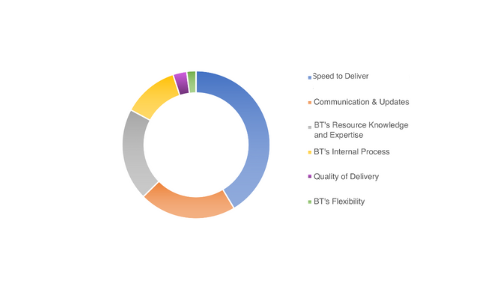
 Personas
Personas
Once the interviews were conducted, all the data collected from interviews were mapped on mural board and personas were developed after data synthesis. These personas were stored in global colleague persona library where other colleague personas were researched on and created.
Digital Order Professional (DOP)
DOP manages and monitors customer orders for a specific area of the portfolio.He works with various stakeholders along the order journey to ensure SLAs are met and orders are delivered on time.
Project Manager
Paul, a qualified Project Manager is responsible for delivering complex customer implementations and ensures customers are happy with the services provided to them.
 Secondary Research
Secondary Research
With respect to different stages of the get journey like validating, decomposing, planning of the commercial order we conducted secondary research so as to get an idea of how order fulfilment works across different industries.
The Process
- Conducted desk research to gather insights on industry trends across different stages of the get journey.
- Referred to various credited sources going along different stages of the get journey, to get an idea of what can be the proposed road map ideas and blue sky ideas, that can be implemented in the to-be journey to make experience better.
- Ideas around orchestration, analytic, data fabrics, robotics and hyper automation were some of the areas which came as key insights through research. (Full deck can be visited here)
- Did competitive analysis around different tools that are used in market for order management which helped in understanding what technical difficulties/challenges current system is causing.
 Experience Map
Experience Map
We wanted to show a visual view of the interactions between customer and colleague throughout the fulfilment stage in a story format through a experience map for different propositions. This would help us in creating a visual journey of the get journey and give a clear understanding of the people involved and actions taking place between them throughout the Get journey.
- The objective was to paint a clear picture to all the stakeholders of the journey through storyboard approach.
- I started with creating the experience map for Teams SKU4 proposition.
- So as to understand the proposition better and all the detailed steps in it, I had multiple sessions with the proposition lead.
- The concept was to start the experience map with a scenario which gives a plot behind what the order scenario (customer info, what products/sevices were ordered) is, followed by brief on the actors involved in the journey.
- And then starts the visual story of get journey which shows the interaction between the colleague and customer actors involved and shows the steps right after the contract between customer and colleague has been signed till the delivery of the order at customers location i.e covering the entire get journey. It also focuses on the touchpoints through which the actors are interacting, captures their step-by-step actions in logical order across different stages of the Fulfilment cycle and gives the reader/viewer a holistic view of how the entire order fulfilment happens.
 Mapping of Customer needs, actions, pain points on Service Blueprint
Mapping of Customer needs, actions, pain points on Service Blueprint
Collaboratively worked along with the service designer to map out the insights derived from the research onto the blueprint.
Collaborated on creating a summary of service blueprint in easier format to be understood and referred by stakeholders.
 Outcome & Impact
Outcome & Impact
The project resulted in a comprehensive service blueprint that mapped the telecom fulfilment journey, identifying inefficiencies and opportunities for improvement. This blueprint became a single source of truth for 100% of the team, including analysts, developers, and decision-makers, ensuring alignment across all stakeholders. Additionally, I created a one-stop research repository, serving as the central reference point for all research-related insights, which streamlined the team’s access to critical information.
The research also opened new avenues to explore deeper customer issues, with the 5 Whys approach planned to further investigate the root causes of user pain points. This deeper analysis helped lay the foundation for data-backed decision-making, providing a structured framework for future research and service enhancements. The impact of these efforts was recognized and rewarded, with client recognition for the quality of customer research and its contribution to shaping the project’s direction.
While the project was ongoing when I left, the groundwork laid through the blueprint and research insights promised significant improvements in service activation speed, streamlined workflows, and enhanced customer experience.
 Challenges
Challenges
Convincing the client to pursue customer-oriented research was a significant challenge, as it required extensive effort and strategic persuasion. The client was initially hesitant, perceiving the research as a potential disruption rather than a beneficial investment.
To address this, I meticulously crafted a detailed research plan that outlined the objectives, methodologies, and anticipated benefits in clear, compelling terms. By presenting concrete examples of past successes and demonstrating the tangible value of user insights, I was able to build a strong case for the research. This comprehensive approach, coupled with persistent communication and stakeholder engagement, ultimately won the client’s approval, allowing the project to proceed successfully.
 Reflection
Reflection
Industry Takeaway
Customer Research conducted opened doors to much broader questions whose answers were yet to be discovered, which I believe will eventually need another phase of research. I prepared a list of questions which needed broader answer in terms of qualitative research to understand and discover the why behind these set of questions which would eventually add more value to the service and handed it to the client’s internal customer-oriented team as a suggestion.
Service designing was an in-progress project. Once the generic version was created, work for individual proposition to-be journey was expected.
Personal Takeaway
Being the only researcher working alongside service designer gave me opportunity to understand the intricacies of service designing and the process that goes into it.
This also gave me opportunity to work as a researcher for Buy and Use stage to understand user experiences.






